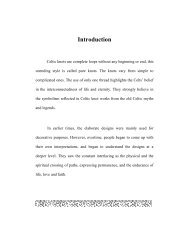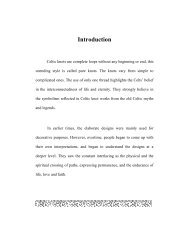Create successful ePaper yourself
Turn your PDF publications into a flip-book with our unique Google optimized e-Paper software.
Introduction<br />
Celtic knots are complete loops without any beginning or end, this<br />
unending style is called pure knots. The knots vary from simple to<br />
complicated ones. The use of only one thread highlights the Celts’ belief<br />
in the interconnectedness of life and eternity. They strongly believe in<br />
the symbolism reflected in Celtic knot works from the old Celtic myths<br />
and legends.<br />
In earlier times, the elaborate designs were mainly used for<br />
decorative purposes. However, overtime, people began to come up with<br />
their own interpretations, and began to understand the designs at a<br />
deeper level. They saw the constant interlacing as the physical and the<br />
spiritual crossing of paths, expressing permanence, and the endurance of<br />
life, love and faith.
History<br />
origins of Celtic knotworks<br />
The Celtic knots were the creation of Celts in the early Celtic<br />
Church who resided mainly in Ireland. Around AD 450, Christian Celtic<br />
artwork was influenced by pagan Celtic sources which incorporated an<br />
additional knotwork category of life form motifs. The Celtic knots then<br />
spread to the Scottish Highlands and Europe via missionary expeditions.<br />
This traditional culture of knotworks in manuscript painting was passed<br />
down orally with non-existent written records.<br />
Many groups of people began to embrace the Celtic art form.<br />
These groups included the Irish, Picts, the Scots of Dal Riada and the<br />
Northumbrians. Celtic knotwork then underwent some form of
adaptation and assimilation with other cultures. An example of this<br />
would be the Anglo-Saxons, Welsh and other religious communities who<br />
created the “Hiberno-Saxon” tradition, which incorporated Saxon and<br />
Pictish abstract beast forms into the early Celtic knotwork. The early<br />
Irish works were consistent in the concept of unending loops, while<br />
Germanic and Roman adaptations had loose ends in some occasions.<br />
Celtic knotworks became the style of that time.<br />
This Celtic golden age of the 7 th to 10 th centuries began its decline<br />
after the Normans’ invasion. In the more Gaelic areas, the Celtic<br />
tradition continued, as these Gaelic aristocrats continued to patronise<br />
Celtic decorated ornaments. The Celtic culture was looked back as the<br />
glory of the ancestors of these people, with the knotwork becoming to an<br />
extent the symbol of political and cultural identity.<br />
Why was it created and which group of people used it
Celtic knotworks were created for secular and religious purposes.<br />
It was meant for decorative aims to ornate Bible manuscripts and<br />
monuments like Celtic crosses and jewellery. The early Celts began this<br />
legacy of knotworks that consisted of animals and spirals, drawn with<br />
such detail that they became known as the “work of angels”. Each knot<br />
meant a virtue like strength or love.<br />
Celtic book like the book of Durrow illustrates the early Irish<br />
style where ribbons are coloured in a certain way. The book of Kells is<br />
renowned as an indispensable source of classic Celtic knots and<br />
ornaments, decorating the four Gospels. These books show many<br />
variations of Celtic knot works such as interlacing, spiral patterns, key<br />
patterns, ropework and plaiting, which are geometric patterns.
Meanings of knotwork<br />
Researchers have been trying to discover the secret of knotwork<br />
patterns, to find out if there is any particular significance behind each<br />
intricate design. In actual fact, the Celts did not assign special ideas<br />
or concepts to the patterns but used them mainly as decorations on<br />
sculptures and jewellery or to fill up empty spaces in illuminated<br />
manuscripts.<br />
However, the interlaced patterns reflected the belief of the Celts in<br />
the interconnectedness and continuity of life. Over time, modern<br />
meanings have been attached to certain designs but these are based<br />
mainly on personal interpretation and may vary between countries<br />
and between individuals.
General patterns<br />
Knotwork Interlace- The pattern shows the interconnection of life and<br />
mankind’s place within the universe. For instance, the Trinity knot<br />
represents the Holy Trinity or the Triple Gods/Goddesses of the ancient<br />
Celts; and the Lover's Knot represents the concept of two become one<br />
(resembles intertwined infinity symbols).<br />
Spirals- Spirals shows the accomplishment of an individual to balance<br />
his inner and outer self and reflects on his personal spirit. The pattern<br />
also symbolizes the Cosmos, Heavens and Water (waves). An example is<br />
the Triskel, the pattern is believed to stand for the Holy Trinity or the
Triple Gods/Goddesses of the ancient Celts which is similar to the<br />
Trinity Knot (above).<br />
Maze and Step Patterns- It represents the learning process and<br />
experiences of an individual as he goes on his journey through life.<br />
Geometric motifs<br />
Celtic artwork has always been famous for its geometric motifs.<br />
Some of these outstanding works date back to 3000 BC and can still be<br />
found on stone carvings today.
The picture shows a single clockwise spiral. This design has the oldest<br />
history and is the most recorded of the motifs. In some culture, the single spiral<br />
may symbolize growth, expansion and even cosmic energy. For instance, the<br />
ancient inhabitants of Ireland used the spiral to represent the sun and a tightly<br />
wound, clockwise spiral to signify their shrinking winter sun.<br />
This loosely wound anti-clockwise spiral is a symbol of the large<br />
summer sun.
The dual centered spiral is also frequently used in stone carvings.<br />
It has associations with motifs from other cultures such as the Yin<br />
Yang symbol. It signifies the duality of nature and balance.<br />
A double spiral is used to represent the equinoxes, the period of<br />
the year when the length of the day and night are the same and they<br />
occupy twelve hours each of the entire day.
The Christian monks in earlier times used this Triple centered<br />
spiral in their illuminated manuscripts. The design originated as a<br />
symbol of the Triple Goddess, pre-dating Christianity.<br />
This pattern is known as Chevrons. It resembles the arrowheads<br />
used by hunters and warriors and was a symbol of power among the<br />
Celts. The motif looks almost heart shaped and occurs in repeated<br />
patterns in ornaments.<br />
Flowing scroll patterns were mainly used for decorative purposes.<br />
Many examples of such patterns can be found in the Book of Durrow,<br />
an illuminated manuscript.
Known as the Ulbster Cross, the design is an illustration of<br />
knotwork interlace pattern. A single thread is used to finish the entire<br />
design and it symbolizes eternity.<br />
Knots<br />
circle of life.<br />
The Eternity Celtic knot symbolizes the never-ending eternal
This Shield Celtic knot has protective significances. Found on<br />
shields of warriors, children’s clothes, the ancient Celts also believed<br />
that the knotwork can protect the sick.<br />
The Triquetra Knot is also known as the Trinity Knot. It is used<br />
by the Christians to stand for the Father, Son & Holy Spirit. However,<br />
this information may not be entirely accurate because the Catholics of<br />
Ireland were the first to use the design to as a symbol in reference to the<br />
Trinity.<br />
It is believed that Celts use this Celtic Cross as a symbol of faith.
This is known as Brigit's Cross. These Irish crosses are made with<br />
wheat weavings and can be found all over the Irish countryside.<br />
According to Irish legends, there was a heroic warrior named<br />
Fionn who had courage, intelligence and strength. This Celtic knot has<br />
been linked with some articles that are reputed to have belonged to him.<br />
The Irish Shamrock is the traditional symbol of the Trinity.
This knotwork shows 8 hearts bounded by a Celtic circle. On<br />
looking closely, one will find the rune of love "X" hidden within the<br />
design. The Celtic Love Knot is believed to be able to enliven<br />
relationships, heighten passions and to attract true love.<br />
A sacred symbol of the Celts, The Triscele represents the eternal<br />
rhythm of life that mankind are a part of. This ancient symbol represents<br />
the trinity of life and was adorned at their most sacred. The main<br />
significance of it was that it symbolizes the Goddess in all her forms ~<br />
Maiden, Mother and Crone.
This amulet design symbolizes peace. Ancient Celts wear it,<br />
hoping to attain peace in oneself and in relationships with others.<br />
The Sailor's knot is also known as the lover's knot. The design is<br />
made up of two separate knots which are intertwined. It is a trend among<br />
Celtic sailors to use this knot in their artwork intended for their<br />
sweethearts.<br />
More knots<br />
Warrior spirit<br />
Shield of Destiny
Love Knot<br />
Inner Strength<br />
Eternity of Nature<br />
Wisdom<br />
Strength<br />
Sexuality<br />
Relationships<br />
Luck<br />
Love<br />
Artistic
Mathematical observations<br />
There are many types of knotwork in various religions or groups. However,<br />
below are the observations that distinguished celtic knots from others:<br />
1) The strong diagonals in celtic knots are based on the 3:4:5 triangle,<br />
otherwise known as the right-angle triangle.<br />
2) At almost every corner of any celtic knots, we can see pointed spades.<br />
This is done so as to connect the cord element to fit a corner.<br />
3) The interlacing of the cords is consistent; they alternate between<br />
“overs” and “unders”, which ultimately contributes to an overall<br />
spiralling look.<br />
4) The basic pattern repeats.
5) The path of celtic knots is continuous. To explain, this means that if<br />
we cut a single cord, pull the two ends, and the panel tightens, then it is a<br />
Celtic knot. If it unravels then it is interlace.<br />
Drawing celtic knots :<br />
1a) Iain Bain’s 3-cord design<br />
Step 1 Step 2<br />
Step 1:<br />
Draw a 20cm by 3cm rectangle. (Only a suggested dimension). Draw<br />
lines(horizontal and vertical) in between so that the intervals between the<br />
lines are 0.5cm. Put small dots at the intersection of dark horizontal and<br />
light vertical lines, like what is shown in the figure below. (To check,<br />
there should be 2 rows of dots with a height of 1cm.)<br />
Note: Do all these very lightly with a pencil.
Step 2:<br />
Connect the dots diagonally(45degrees), forming crosses between the 2<br />
horizontal lines.<br />
Step 3 Step 4<br />
Step 3:<br />
Extend the set of diagonal lines to form points above and below the<br />
initial lines. If you number the top row of dots 1, 2, 3, 4, and so on, from<br />
left to right, your peaks should be between 1 and 2, 3 and 4, etc. Not<br />
between 2 and 3, 4 and 5, etc. (To check, you will get a zig-zag path-like<br />
figure.)<br />
Step 4:<br />
Connect the points with arches. The points that move into the corners are<br />
shaped with points. Make sure that the arches are of constant width.
Step 5 Step 6<br />
Step 5:<br />
Erase the dots.<br />
Step 6:<br />
Erase the cord lines from each intersection so that one cord goes over the<br />
other. Remember that you must alternate between “overs” and “unders”<br />
to create a weaving effect.<br />
Step 7 Step 8<br />
Step 7:<br />
Clean up any stray marks. This stage is known as the knotwork plait.
Step 8:<br />
Break the plait at every 5cm horizontally by erasing the lines where they<br />
cross so that we get 3 rectangles each measuring 5cm by 3cm. Then<br />
reattach the lines so that the corners are shaped with points, like what we<br />
did in step 4. (To check, see that each cord goes back on itself instead of<br />
continuing along the plait.)<br />
1 b) Iain Bain’s 4-cord design<br />
Step 1 Step 2<br />
S tep 1:<br />
Draw a 18cm by 4cm rectangle. (Only a suggested dimension). Draw<br />
lines(horizontal and vertical) in between so that the intervals between the<br />
lines are 0.5cm. We will label the dark horizontal lines as 1cm, 2 cm,
and so on for easy reference; the same goes for the vertical lines. Put<br />
small dots at the intersection of even-numbered horizontal lines(2cm and<br />
4cm) and odd-numbered vertical lines. Then put 2 dots on the line: one<br />
3/4 down the square and the other 1/4 down. (To check, there should be<br />
2 rows of dots with a height of 2cm.)<br />
Note: Do all these very lightly with a pencil<br />
S teps 2 to 7 are exactly the same as the above.<br />
Note: Instead of 1 pointed spade each at the top left and right corners<br />
only , there should be 1 pointed spade each at the bottom left and right<br />
corners as well.<br />
S tep 8:
Break the plait at every 6cm horizontally by erasing the lines where they<br />
cross so that we get 2 rectangles each measuring 6cm by 2cm. Then<br />
reattach the lines so that the corners are shaped with points, like what we<br />
did in step 4. (To check, see that each cord goes back on itself instead of<br />
continuing along the plait.)<br />
2 ) Marc Wallace’s simplified construction of a knot<br />
S tep 1:<br />
Draw a grid with even number of squares in both directions. For<br />
example, you can draw a 6cm by 6cm grid with 1cm intervals. Put dots<br />
at the midpoints of the sides of each small square, where the sides are<br />
2cm.
Step 2:<br />
A splitting is a line through which the knot is not allowed to pass. These<br />
lines are drawn slightly shorter than 2cm, and are centered on the dots<br />
drawn in the previous step. Place splittings on all the dots along the<br />
border of the grid(external spittings).<br />
Step 3:<br />
All internal splittings are either horizontal or vertical, and only 1<br />
splitting can be placed at each dot. Draw the internal splitting as shown:<br />
PS: This is only one example of an internal splitting.
Step 4:<br />
Connect the remaining dots diagonally. However, do not connect them<br />
completely from dot to dot so that we have a small distance between the<br />
connecting lines and dots.<br />
Step5:<br />
Going diagonally outwards from each dot, if the dot is approaching a<br />
splitting, draw a short curve out from just past the dot to the edge of the<br />
grid square, making sure not touching it. The curve should go straight<br />
towards the dot, and should be parallel(at the peak of the curve) to the<br />
splitting where it meets the grid edge. Take note that the curve should<br />
not touch the dots.
Step 6:<br />
Wherever a horizontal splitting and a vertical splitting meet in a corner,<br />
the knot will also have a sharp corner. Draw these corners in a way such<br />
that they join the short curves smoothly.<br />
Step 7:<br />
Notice that there are disjoints(ignoring the spaces between dots) in the<br />
figure. Fill in the disjoints by drawing straight-line segments.
Step 8:<br />
Wherever there is a dot, fill in the space as follows:<br />
--On odd rows, let the right piece overlap the left piece.<br />
--On even rows, let the left piece overlap the right piece.<br />
Step 9:<br />
Erase all construction lines and the knot is complete.
Uses<br />
There are a wide variety of uses for Celtic knots. Its complicated and yet,<br />
intricate designs have enabled artists to incorporate them into their<br />
works. Celtic knots can be used to decorate simple merchandise and also<br />
be used to bring about a dignified elegance to every occasion.<br />
The Celtic knots have graced many different types of jewellery.<br />
For instance, the Celtic love knots have been used on many occasions to<br />
celebrate the union of two individuals with Celtic designed rings. The<br />
uniqueness of using only one cord to weave a complicated pattern<br />
implies the continuity of paths, by which one could interpret to mean<br />
eternal<br />
love in a relationship.
Rings.<br />
Bangles<br />
Amulets
Pendants<br />
Earrings<br />
Cuff Links
Jewellery Sets
The Celtic knotwork designs are also used when food is concern.<br />
It can be found on kitchenware as well as on the food itself!<br />
Cake Motifs<br />
Mugs<br />
Plates
Celtic knife and cake server<br />
and bags.<br />
Amazingly, Celtic knots has also found its way onto our clothes<br />
Celtic dresses
Apron<br />
Tote bag<br />
Celtic knots are often used for decorative purposes, such as<br />
ornaments, stationeries, wall arts, tapestries, cross stitch designs and<br />
many more. There isn’t a lack of places where you can apply the<br />
knowledge of Celtic knotworks.
Wooden ornaments<br />
Wooden Signs
Money pins<br />
Cards<br />
Illustrations
Bibliographies<br />
Books<br />
Green, Miranda Celtic Art Calmann & King Ltd 1996<br />
Lawthes, Gail Celtic Cross Stitch-30 alphabet, animals & knotwork<br />
projects David & Charles 1996<br />
Sandison, David The Art of the Celts Reed International Books Ltd 1998<br />
Starmore, Alice Celtic Needlepoin Anaya Publishers Ltd 1994 (1st<br />
published) Collias & Brown Ltd (paperback edition)<br />
Wainwright, Angela Celtic-cross stitch samplers Cassell<br />
1995<br />
Website Sources<br />
“Aon Celtic Art and Illumination” available from
http://www.aon-celtic.com/index.html<br />
“Celtic Spirit” (2002) available from<br />
http://www.celticspirit.com/<br />
“Celtic Attic” available from<br />
http://www.celticattic.com/contact_us/the_celts/celtic_nations/celtic_kno<br />
twork_and_meaning.htm<br />
‘Celtic One Design” available from<br />
http://celticonedesign.bravepages.com/<br />
“Cake Pix Ltd” (2002) available from<br />
http://www.cakepix.co.uk/<br />
“deSignet International” (2000-2003) available from<br />
http://www.celticfolklore.com /
Drew Ivan’s “Knotwork meaning” (27 MAY 1999) available from<br />
http://www.craytech.com/drew /knotwork/knotwork-meaning.html<br />
Jim Potts’ “Celtic signs” available from<br />
h ttp://www.celticsigns.com/<br />
“Irish Wedding Catalog.com” (2003) available from<br />
h ttp://www.irishweddingcatalog.com/<br />
“Celtic United” available from<br />
http://www.celticunited.com/listings/3.html<br />
Mary Lockwood’s “Celtic Artwork and Knots” available from<br />
h ttp://celticreations.com/artwortknots.html<br />
“Custom Cuff Links & Tuxedo Stud Sets” (1995-2003) available from<br />
http://www.custom-cufflinks.com/
Stephen Walker’s “In Search of Meaning: Symbolism of Celtic<br />
Knotwork” (18 January 2001) available from<br />
http://www.celtarts.com/in_search_of_m eaning.html<br />
Stephen Walker’s “Metalsmiths, celtic jewellery; knotwork history and<br />
symbolism” (18 January 2001) available from<br />
h ttp://www.celtarts.com/history.htm<br />
Eric W. Weisstein’s “Wolfram Research, Inc” (1999) available from<br />
h ttp://mathworld.wolfram.com/Knot.html<br />
Suzanne Gordon’s “Muse angel” (11-1-2002) available from<br />
http://www.museangel.net/knot.html<br />
Ivan Drew’s “The Celts” available from<br />
http://www.craytech.com/drew/knotwork/celthome.html<br />
“Prime Mathematics Enrichment” available from<br />
http://www.nrich.maths.org.uk/prime/mar00/magazine.htm
Steve Abbott's Computer Drawn Celtic Knotwork” available from<br />
http://www.abbott.demon.co.uk/knots.html<br />
“The 3-4-5 triangle” available from<br />
http://www.tpub.com/math1/20f.htm<br />
Wallace, Marc and Shelly “Celtic knots” available from<br />
http://www.wallace.net/knots/
















